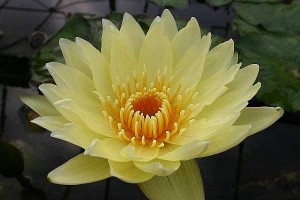 We've been so busy taking orders and shipping orders, we just haven't had time to write on the blog as we should. It has been a whirlwind of a spring so far. Those in planting zones 8 on the west coast have had an usually cold spring and should have had their plants in a month ago. But thanks to good old mother nature, they are still waiting for their normal warm temperatures. Hopefully things have finally warmed up. We held up shipping their plants and it became a daily routine of checking their 10 day forecast to see if they could climb out of the 50 degree weather they were experiencing. That was their high! For those of us in the lower planting zones, we should be able to begin putting our plants in the pond, mother nature cooperates for a couple days and then slips in a few fridgid night time lows in the 30s and 40s. What do we do?
We've been so busy taking orders and shipping orders, we just haven't had time to write on the blog as we should. It has been a whirlwind of a spring so far. Those in planting zones 8 on the west coast have had an usually cold spring and should have had their plants in a month ago. But thanks to good old mother nature, they are still waiting for their normal warm temperatures. Hopefully things have finally warmed up. We held up shipping their plants and it became a daily routine of checking their 10 day forecast to see if they could climb out of the 50 degree weather they were experiencing. That was their high! For those of us in the lower planting zones, we should be able to begin putting our plants in the pond, mother nature cooperates for a couple days and then slips in a few fridgid night time lows in the 30s and 40s. What do we do?
Just remember, we need to play it safe and make sure the weather is going to cooperate and keep our new plants protected from the cold. If we put water lettuce in too early, the leaves will turn from their nice green to white.....water temperatures too cold. Water hyacinths turn brown......again too cold. Play it safe with your newly purchased plants and if you think the weather is still too cold, put them in a container and keep them indoors for a few days. If it is warm during the day, go ahead and place them outside to get the sun. I would rather play it safe and protect the plants, then to take a chance of them dying and having to replace them. We do our best to ship the plants when it is safe for you to put them in your pond. We watch the weather highs and lows across the nation and try to ship the plants accordingly. Unfortunately, those cold fronts coming down from Canada, make it somewhat difficult to second guess Mother Nature!
Next month hopefully we will all be sitting by our ponds thinking how nice everything looks and forget about the crazy spring we just had.
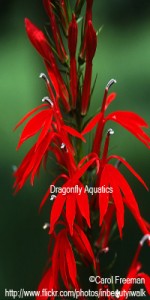 I thought I'd publish this article we wrote last year again. When trying to get some of the bog plants started in your ponds its best to start them out slowly in the water, since most of them are swamp like plants. They can tolerate a few inches above their pot once they are established and growing. When growing them in our greenhouses we have them growing in two inch net pots in bins that have about one inch of water in them so the water is keeping their roots wet.
I thought I'd publish this article we wrote last year again. When trying to get some of the bog plants started in your ponds its best to start them out slowly in the water, since most of them are swamp like plants. They can tolerate a few inches above their pot once they are established and growing. When growing them in our greenhouses we have them growing in two inch net pots in bins that have about one inch of water in them so the water is keeping their roots wet.
Here's the article.
I've been wanting to write something on this subject for some time now. Finally, I have a bit of time to address the subject of water depth for bog plants and marginal plants. Simply put, bog plants like their "feet" wet. Translation....roots and soil moist at all times. When the plants are first planted, this is especially important. Many of the bog plants will take deeper water as they mature and spread. But, when you first receive your bog plants, you will have better success if you place them where there is no more than a half inch or less of water above the soil line. Think of the marshes and swampy areas, you have passed while traveling down the road. These natural reservoirs, fill during the rainy season and will dry out during dry spells. The plants adjust to the varying water depth and grow and spread rapidly. If you have a question on a particular plant, just ask and we will be happy to help you plant and grow beautiful marginal and bog plants.
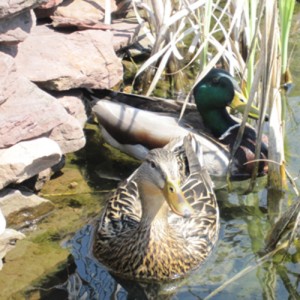 Walked out to the pond the other morning, and there they were, a pair of Mallard Ducks! My first thought was, oh how pretty they are, and what a cute couple they make! I started to have visions of the nest they would build next to the pond, after that the family of ducklings would appear. It would be so wonderful to watch them grow up, learn to swim, follow their parents around and in the pond. Then the voice of reason came! Ducks are not really welcome visitors to your backyard water garden. Unfortunately, ducks make a mess. Their droppings add unwanted nutrients to your pond. Not to mention, they are vegetarian for the most part, and they will eat your plants. The same plants you have spent your money on, they will eat. So, I listened to that voice of reason, scared the pair off, made them feel unwelcome and they have not been back since. I'm sure they have found one of the larger ponds or lakes in the area to call home.
Walked out to the pond the other morning, and there they were, a pair of Mallard Ducks! My first thought was, oh how pretty they are, and what a cute couple they make! I started to have visions of the nest they would build next to the pond, after that the family of ducklings would appear. It would be so wonderful to watch them grow up, learn to swim, follow their parents around and in the pond. Then the voice of reason came! Ducks are not really welcome visitors to your backyard water garden. Unfortunately, ducks make a mess. Their droppings add unwanted nutrients to your pond. Not to mention, they are vegetarian for the most part, and they will eat your plants. The same plants you have spent your money on, they will eat. So, I listened to that voice of reason, scared the pair off, made them feel unwelcome and they have not been back since. I'm sure they have found one of the larger ponds or lakes in the area to call home.
Here we go again. I call it the Spring Tease. Just when plants are beginning to sprout and the warm weather hits....big time....it teases us with a mention of snow! The cold front here in Ohio and across the north has moved in for a few days. If you have already put plants out in your ponds, be sure and bring them in or protect them.
I was going to clean my pond last week, but with taking care of our customers and being busy taking your orders and sending orders I just haven't gotten around to it yet. I did see that I had some marsh marigolds blooming and bog bean. It gets me anxious, wanting to put more plants out. Good thing I held back. I'll just leave them be in the nursery where they are nice and warm. Besides, I really need to clean my pond at home since I neglected to do that last year. It's pretty bad. I think I need the Microbe-Lift Sludge Away. I have alot of build up of sludge on the bottom of my pond. Maybe then I'll only need to change out half the water this year. I did start putting the Microbe-Lift Spring and Summer in a couple weeks back and the water is crystal clear, but now you can really see the goop at the bottom. For those that haven't tried the Microbe-Lift Sludge Away it works great at speeding up the removal of sludge & muck naturally.
It is especially helpful for ponds that have a rock or gravel bottom, where vacuuming is impractical. Microbe-Lift SA/Sludge Away is formulated specifically for the removal of organic bottom solids that are slow to degrade but works faster at warm water temperatures, however, Microbe-Lift SA/Sludge Away may be used effectively at any temperature year-round.
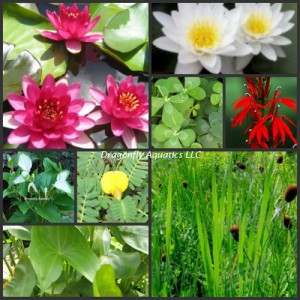 We had highs in the low to mid 80's the last couple of days here in Ohio. One week snow, the next unseasonably warm. Don't want to get too used to it though, next week we will be back to the normal spring time temperatures. Normal here this time of year is mid 50's to mid 60's. Nothing like a few warm days though to get people out working on their ponds. The weather has been on the unusual side. One week snow, the next record breaking high temperatures. It makes it very difficult to know when to ship plants. Many of the plants we sell are cold sensitive and trying to second guess Mother Nature is sometimes impossible! We have customers in the Pacific Northwest that are still freezing, the time has passed when we usually can start to send their plants. Old Man Winter just isn't moving out of that part of the country yet. Hopefully, things will start to warm up for them in the next week or two. And for us in Ohio, we can only hope the milder temperatures will continue. We just want to remind everyone, just because you are having warm temperatures today, does not mean it is safe to put plants out before your last frost date. It has been such a long winter, I know everyone is a little impatient....I am too! But, always remember, Mother Nature likes to throw curve balls at us! Just when we think it is safe to put plants out, along comes a freeze warning!
We had highs in the low to mid 80's the last couple of days here in Ohio. One week snow, the next unseasonably warm. Don't want to get too used to it though, next week we will be back to the normal spring time temperatures. Normal here this time of year is mid 50's to mid 60's. Nothing like a few warm days though to get people out working on their ponds. The weather has been on the unusual side. One week snow, the next record breaking high temperatures. It makes it very difficult to know when to ship plants. Many of the plants we sell are cold sensitive and trying to second guess Mother Nature is sometimes impossible! We have customers in the Pacific Northwest that are still freezing, the time has passed when we usually can start to send their plants. Old Man Winter just isn't moving out of that part of the country yet. Hopefully, things will start to warm up for them in the next week or two. And for us in Ohio, we can only hope the milder temperatures will continue. We just want to remind everyone, just because you are having warm temperatures today, does not mean it is safe to put plants out before your last frost date. It has been such a long winter, I know everyone is a little impatient....I am too! But, always remember, Mother Nature likes to throw curve balls at us! Just when we think it is safe to put plants out, along comes a freeze warning!
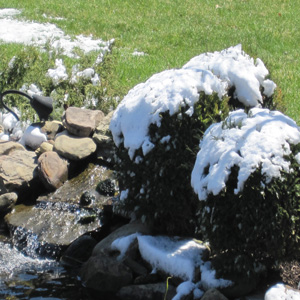 This is what some of us in the North woke up to this morning, and this was after some of it had melted. What happened to those 50 and 60 degree days??? Hopefully they will be back again soon. How can we get started cleaning our ponds and thinking putting those new plants in if the water is too cold to put our hand in it. And what about those fish and frogs???? They are hiding again.
This is what some of us in the North woke up to this morning, and this was after some of it had melted. What happened to those 50 and 60 degree days??? Hopefully they will be back again soon. How can we get started cleaning our ponds and thinking putting those new plants in if the water is too cold to put our hand in it. And what about those fish and frogs???? They are hiding again.
Whenever this happens, those of us who wanted our plants shipped thinking its finally warm wonder, now what do I do with them. Make sure you protect them by bringing them indoors until it warms up. Remember most of the plants have been indoors in a greenhouse environment and shiver even when the temps are in the 60s. But we need to make sure the water temperature have stabilized to 65 degrees before we put those floating plants out.
The floating water plants in your pond need to have the water temperature reach 65 degrees. They will show signs of yellowing leaves and black spots on their leaves if left in water temps below that. The water lettuce will wilt and turn white if too cold. We tend to get anxious in the spring and sometimes put floaters in before the water is warm enough. Even the lotus and waterlilies need the warmer weather to start growing. But at least those were outside all winter and were pulled to ship out.
Hopefully, like last year, this is a short spell and in a couple weeks things will turn around and we can once again start looking forward to enjoying our ponds.
 Unfortunately, our ponds exist outdoors and raccoons, blue herons and other wildlife are constantly visiting our piece of paradise. After all, they have to eat too! We have several products to help keep your fish, snails and frogs safe from becoming a gourmet meal for the local wildlife! We will be posting these products in the coming days or call us if you would like specific instruction on how best to deter the varmints attacking your fish!
Unfortunately, our ponds exist outdoors and raccoons, blue herons and other wildlife are constantly visiting our piece of paradise. After all, they have to eat too! We have several products to help keep your fish, snails and frogs safe from becoming a gourmet meal for the local wildlife! We will be posting these products in the coming days or call us if you would like specific instruction on how best to deter the varmints attacking your fish!
With spring here and hardly any coverage on our ponds it gives those predators a clear picture of our fish swimming about. Until we can get some coverage to at least help in protecting our fish these items help.
Check out the gator!
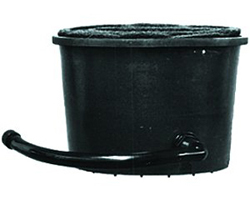 We've covered water temperatures, so what else should we do early spring prior to adding pond plants? We would like to mention a few things you should check when opening your pond for the season.
We've covered water temperatures, so what else should we do early spring prior to adding pond plants? We would like to mention a few things you should check when opening your pond for the season.
Check your pond to make sure there are no tears or leaks in your pond liner. Check around the edges of your pond to make certain the ground has not settled, and your pond is not leaking around the perimeter. Check out all your tubing, connections, pond pumps and filters to make sure they are all secure and working properly. If you have left your pump run throughout the winter make sure it is working properly. And for those who have turned off their pumps, you should check and clean them thoroughly. Turn your pump back on once the water temperatures are consistently above freezing which is around 40-45 degrees.
Remove any debris that has accumulated in your pond during the fall and winter. For those of you that have a pond vac, now is the best time to use those to rid your pond of small unwanted particles. You can begin putting MicrobeLift Spring and Summer in your pond to help with the cleanup. MicrobeLift Spring and Summer contains cold weather bacteria cultures that will work in the cooler water temperatures of spring. This will start establishing good bacteria and help accelerate the break down of debris. The spring rains help to flush your ponds, so if possible drain some of the water out of your pond and let the rain rinse and fill it up.
Once everything has been checked out you can begin thinking about feeding your fish, if you have them, and dividing some of the pond plants that have out grown their planting containers. We will discuss this in our next addition to Here Comes Spring.
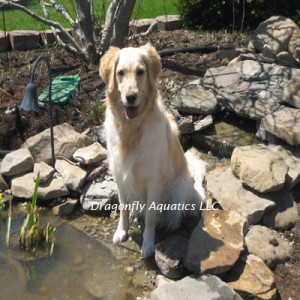 Time to spring forward, or at least turn the clocks forward! Things are beginning to warm up a bit here in the north and we are anxiously waiting for Spring to arrive so we can begin to add new plants to our ponds. Another couple of months and we will be sitting back enjoying our ponds once again. It won't be long now. For those in the warmer regions, zones 8 and above, you are putting pond plants in your ponds and starting to enjoy them, while those of us in the lower zones are still waiting. At least most of the ice has melted and we can begin thinking about our ponds once again.
Time to spring forward, or at least turn the clocks forward! Things are beginning to warm up a bit here in the north and we are anxiously waiting for Spring to arrive so we can begin to add new plants to our ponds. Another couple of months and we will be sitting back enjoying our ponds once again. It won't be long now. For those in the warmer regions, zones 8 and above, you are putting pond plants in your ponds and starting to enjoy them, while those of us in the lower zones are still waiting. At least most of the ice has melted and we can begin thinking about our ponds once again.
Don't be fooled by Mother Nature. We need to make sure it is warm enough outside, and make sure our pond water is warm enough for the plants to survive. Knowing your pond temperature is crucial, so begin by checking your pond water temperature at different times of the day. The pond water is cooler in the morning and warmer in the afternoon but will cool down again in the evening. Knowing what the consistant temperature of your pond water is important before adding the pond plants.
The first plants most of us want to put in are those that will help us keep the pond clear, such as floating plants like water hyacinths and water lettuce. Cold water will kill both of these in a matter of days if the water temperature is still too cold. We need to make sure the water temperature is consistent and reaches 65 degrees and stays there morning, afternoon and evening before we add floating plants.
There are other things we must do first that will keep us busy, such as adding beneficial bacteria to help keep our pond clear. The good bacteria, such as MicrobeLift PL neutralizes ammonia and nitrites, and will start to work when the water temperature are 50-55 degrees. If you add bacteria, it will stay in the pond and start working when the pond water is warm enough. It acts on its own and will stay un-activated until it knows to start working. For those of us who use barley, now is the right time to start adding it. This will also help retard the growth of string algae in the Spring months.
The list goes on and on. While all of us are anxious to add the pond plants there are still several things to do prior to this. I will be posting articles in the next few days with spring tips for our ponds.
Stay tuned!
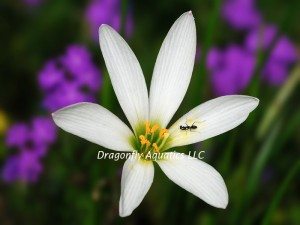 As we get ready for another season, Dragonfly Aquatics is currently working on adding some new plants for the 2010 season. In the upcoming weeks we will be announcing our new plant varieties.
As we get ready for another season, Dragonfly Aquatics is currently working on adding some new plants for the 2010 season. In the upcoming weeks we will be announcing our new plant varieties.
The first we've added are our new Lotus for 2010. The Penelope and Double Rose. The Penelope is a pure white lotus and the Double Rose is a pink full lotus. Both are a great addition to our store. You can find more information on them on our site. https://www.dragonflyaquatics.com/lotus.html
The newest bog plant we've added this year is the Rain Lily or Zephyranthes candida. They have six-petaled flowers that are 1-3 inches across with grassy foliage and grow 3 - 10 inches tall. They grow in full sun to part shade in moist soil or water to 3 inches deep. They are a tender perennial bulbs and hardy in Zone 8 and up. They have however, survived in Zones 5 or 6. You can winter these over by taking them indoors. Just don't water them until you return them to the pond in the spring. They go dormant in the dry season and grow and flower in the wet season.
You can purchase Rain Lilies here on sale through end of March, 2010.